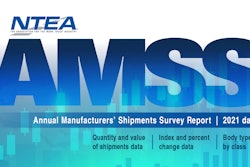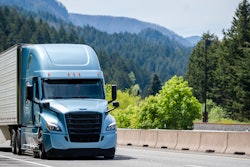Where the bill could have an impact is in accelerating the ongoing migration toward electric vehicles, as there are billions of dollars up for grabs for electric vehicles and infrastructure build-out.
[Related: How to claim Inflation Reduction Act tax credits to expedite green trucking]
Joining Jason and Matt this week on CCJ's 10-44 is Dave Mullaney, a principal on the Rocky Mountain Institute's Carbon-Free Mobility Team, who says those incentives could not have come at a better time.
CCJ's 10-44 is a weekly video feature covering the latest in trucking news and trends, equipment and technology. Subscribe to our YouTube channel here.
Contents of this episode
00:00 Electric trucks and the Inflation Reduction Act
03:19 Lowering emissions
06:07 Total cost of ownership and electric trucks
06:59 Demand and supply chain issues
08:41 Meeting electricity demands
Video transcript
Jason Cannon
Hey, everybody. Welcome to the 10-44, a weekly web episode from the editors here at CCJ. I'm Jason Cannon, and my co-host on the other side is Matt Cole.
While it's eased off slightly, inflation is still among the top consumer concerns of 2022. To combat that, President Joe Biden in August signed the Inflation Reduction Act. The IRA itself takes aim at a lot of things like corporate taxes and prescription drug costs, but a study conducted by the University of Pennsylvania found there's almost no chance this bill will have any influence at all on inflation.
Matt Cole
Where the bill could have an impact is in accelerating the ongoing migration toward electric vehicles. There are billions of dollars up for grabs for families and businesses that are willing to convert to clean energy.
Jason Cannon
Freight transportation moves about 70% of goods in the market in the U.S. And the IRA places a $40,000 tax credit in front of buyers of medium- and heavy-duty zero emission vehicles, and up to a $100,000 in tax credits for the construction of electric vehicle charging stations. Dave Mullaney, a principal on the Rocky Mountain Institute's Carbon Free Mobility Team, says those incentives could not have come at a better time.
Dave Mullaney
All of these electric trucks that are coming out on the market today, like the Volvo, the VNR Electric, the Daimler, the eCascadia, the Nikola Tre, all of these things, they're all going to qualify for the full subsidy amount, which is $40,000.
And we've gone and looked at, what does this do to the cost per mile of using an electric truck versus the cost per mile of using a diesel truck. And for the shorter segments, those where battery sizes can be smaller, so imagine urban trucking or the regional stuff, so short to medium haul with these sort of return-to-base applications where you could charge overnight, you start to see cost per mile, that with these subsidies are getting competitive with diesel. So, we think that, especially in those market segments, it could mean pretty quick adoption and a lot of demand out there. Good for the truck builders, obviously, that their products are going to be competitive.
There's an increasing, I'd say, both confidence in the technology, but also the performance of the technology has improved a lot. Recently, you've seen a lot of the, basically, every big truck manufacturer start to come in with the electric heavy-duty product offering. I was at the ACT Expo earlier this year, and International introduced to their electric truck. And I think Volvo and Daimler both had theirs on the floor. And Xos is a new startup. They introduced their heavy-duty truck.
So, all of a sudden, the product was there. And you're starting to see fleets deploy these things in real life circumstances. The product was there. People were getting confident about their ability to use it. It was still expensive. And it was expensive, one, because batteries are expensive. But also because it's small scale manufacturing. The demand was uncertain because the costs were high. So, this whole extra tax credit in a lot of ways really puts it over the hump, makes the costs pretty compelling in the right applications. And then, I think the manufacturers looked at this and they say, "This is a market that I can go after, big time now." And then, they can get their economies of scale. They can reduce production costs. And hopefully, in the not-too-distant future, make the subsidies unnecessary because just the vehicles themselves are able to be produced at a lower cost.
Matt Cole
Trucking accounts for about 40% of all road-transport emissions, and would be the Number Four worst CO2 emitter in the world, if the industry were a country. Considering there's a 300% increase in the amount of road rate forecast by 2050, it's easy to see why our industry draws so much attention when it comes to zero emission.
Matt Cole
Dave said the IRA could reduce the industry's greenhouse gas emissions by 59% in 2035, nearly twice as quickly as what would be expected without the IRA.
Dave Mullaney
We think that, as long as the truck manufacturers are able to roll out these shorter- to medium-range electric trucks, with this incentive package, people want to buy them. That makes about a quarter of GHG emissions from the trucking industry pretty easy to get rid of cost effectively. It's really around, can we get the vehicle supply out there? We think if we can, people will buy them. That's a bigger question.
We do think that, obviously, this bill does improve the economics of over-the-road trucking. It is going to lead some people probably to get into the battery electric game. But just for over-the-road, the size of the battery pack, you need how much that weighs. And then, the questions of, "I don't have a base to return to. Where am I going to charge this? Is the charging infrastructure out there? It makes the problem a little bit more complicated than just cost effectiveness. There's also, "Can I do it? Is it operationally possible?"
So, that over-the-road trucking is still a little bit out there for us. We think we're going to move that direction, but it's not there, right now.
Jason Cannon
Dave said there's also considerations for total cost of ownership. Adding that TCO on electric trucks in all modes, urban, regional, and long haul will be lower than diesel ones, approximately five years sooner than without the IRA. Dave tells us more about what's driving those TCO savings after a word from 1044 sponsor, Chevron lubricants.
Protecting your diesel engine and its after treatment system has traditionally been a double-edged sword. The same engine oil that is so essential to protecting your engine's internal parts is also responsible for 90% of the ash that is clogging up your DPF and upping your fuel and maintenance costs.
Outdated industry thinking still sees a trade off between engine and emission system protection, and Chevron was tired of it. So, they spent a decade of R&D, developing a no-compromise formulation. Chevron lubricants developed a new ultra low ash diesel engine oil that is specifically designed to combat DPF ash clogging. Delo 600 ADF, with Omnimax technology, cuts sulfate ash by a whopping 60%, which reduces the rate of DPF clogging and extends DPF service life by 2 1/2 times.
And just think what you can do with all the MPGs you're going to add from cutting your number of reagents. The Delo 600 ADF isn't just about after treatment. It provides complete protection, extending drain intervals by preventing oil breakdown. Before, you had to choose between protecting your engine or your after treatment system. And now, you don't. 600 ADF from Delo with Omnimax technology. It's time to kick some ash.
Dave Mullaney
The electric trucks, we're pretty sure, are going to have lower operational costs. Fuel costs is one. How much you got to buy electricity to move an electric vehicle one mile is a lot less than you got to pay for diesel to move a vehicle one mile. So, that's big. Also, the maintenance costs are a pretty substantial reduction on the electric side. It's a simpler machine, less moving parts, less things that are likely to fail. Those are also positives on the side of the electric trucks.
What's always been the problem is that the upfront costs for the electric trucks was very high and it made the timelines over which those reduced operational costs could recoup the extra investment too long for people to be interested in. So, this subsidy, this tax credit is big enough, now, that those timelines for recouping your capital investment have become shorter and people are starting to look at them now and say, "Yeah. That makes a lot of sense. That's an extra cost that I'm willing to pay to achieve those savings."
Matt Cole
Dave said RMI projections based on the tax credits for both the vehicle and the charger infrastructure showed that the IRA will lead to far greater electric truck sales. And by 2030, over 60% of new truck sales could be electric, depending on supply chain issues.
Dave Mullaney
That 60% by 2030 does mean you're starting to get a little bit more into the long-haul segment. So, I guess there's a couple things baked into there. One is, you got to figure out supply, right?
Right now, I think the restrictions on sales aren't about who's willing to buy the vehicles. It's about who's willing to make the vehicles. A lot of these truck manufacturers are really starting to ramp up production. But there's a whole upstream supply chain that involves rare earth elements, battery minerals, that it has yet to be figured out.
We think that there's going to be enough demand for 60% of sales. Whether or not we can get supply is the big unknown for us. And then, also as you start moving towards 2030, right now the questions that are around long haul, they're partly economic, but they're partly around infrastructure, and partly around improvements in the battery chemistry itself.
Going after 2030 always gets speculative. I think we see a pretty clear pathway to get to 40%, 50% market share with today's technology. And then, if you go out eight years, you could see with the way that battery technologies have developed recently, that those longer, more difficult, segments start to come into play. But, anything in 2030 is speculative, right?
It's hard to say where exactly we'll land. But I think the one thing that I'd be comfortable saying here is, we are going to be moving a lot quicker with this bill than without this bill, just because it is really transformative to the economics, especially in the short- and medium-haul segments.
Jason Cannon
With demand projected to exceed supply, Dave said BEV manufacturers will have to ramp up production by a factor of 20 by 2035 while still meeting new North American final assembly requirements. By 2035, the electric grid must be prepared to add 230 terra watt hours of new truck electricity demand, that includes power for nearly 150,000 fast public chargers and 860,000 depot chargers.
Dave Mullaney
If there's one thing that could derail this whole transition, that is probably it. And so, it's not so much generating 230 terr watt hours of electricity. Utilities are good at building generation capacity. They'll be able to do that. The problem is getting it where it needs to be.
That means you need to invest in a lot of transmission lines, transformers. You need to get that electricity to where a truck wants to be. And that really is the biggest challenge for us. And we've been working with a utility in the Northeast, they're called National Grid. And they've been trying to do a little bit of network planning, trying to figure out, what does it mean for trucks to be electrified? What kind of consequences does that impose on us, or what required investment does it impose on us? And it's intimidating for utilities.
Dave Mullaney
And so, especially some of these bigger upgrades to an electrical network, to plan and implement, they can take between five and 10 years. We think that electric trucks are going to become a big thing in the next 10 years. And we do think that. That means that there's a pretty heavy burden on utilities to be able to supply that electricity. And that means investing particularly in transmission networks, investing in the capabilities to deliver a lot of power to specific places.
Dave Mullaney
So, one of the things that we've been working with National Grid is, we've been looking at, "What if trucks along highways started to electrify and long-haul trucks charged it at truck stops overnight. How much power would they need to deliver those places?" And we've done some calculations that, at some of the bigger truck stops in New York, it's close to 50 megawatts. And to put that into context, that's a factory.
Dave Mullaney
So, all of a sudden, what used to be a small restaurant, maybe, with some parking stops and a gas station. Now you have a factory there. And this is going to be happening all over the United States. And utilities are going to have to figure out how to deliver that power. And that's going to be very challenging to them.
Jason Cannon
That's it for this week's 10-44. You can read more on ccjdigital.com. And, as always, you can find the 10-44 each week on CCJ's YouTube channel. And if you've got questions, comments, criticisms, or feedback, please hit us up at [email protected] or give us a call at 404-491-1380.
Until next week, everybody stay safe.












